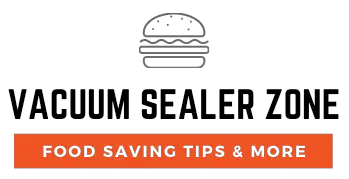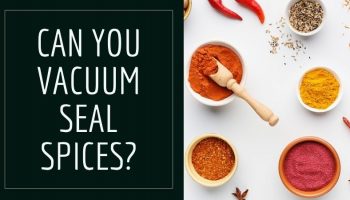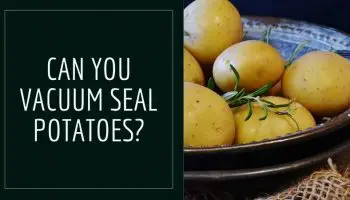For many people vacuum sealing their food is a good alternative for them in the kitchen. This is because of the many benefits it holds including cost-saving and longer food preservation.
Wondering whether you can vacuum seal all your food types? If not, which food varieties cannot be vacuum sealed and why? In this article, we explore the insights about foods that should not be vacuum sealed and possible alternatives.
Foods that Should Not Be Vacuum Sealed
For most foods in the kitchen, vacuum sealing works just fine for them. However, there are a number of foods that you should be cancelled out of your vacuum sealing list. These include;
- Raw mushrooms
- Raw Garlic
- Fresh onions
- Soft cheeses e.g. blue cheese and other unpasteurized cheeses.
- Freshly cooked or steamed vegetables
- Raw cruciferous vegetables
Reasons Not to Vacuum Seal These Foods
Most bacteria and fungi will thrive under oxygen but not all. These varieties of foods contain anaerobic bacteria. Anaerobic bacteria are active in the absence of oxygen.
Vacuum sealing sucks out air in food but without the air, these bacteria will grow and thrive. Therefore, vacuum sealing these foods will lead to food poisoning when consumed.
Vacuum Sealing Raw Garlic, Onions, and Mushrooms
We have seen that these sets of foods produce bacteria. So, what are the specific bacteria, and how much risk health is involved? Under low oxygen conditions, a certain bacteria species is produced which leads to botulism.
Moreover, these foods will produce gases when preserved raw. These gases will enlarge the packages, break the seals, and can also cause illnesses. To add to that, raw mushrooms have high water content making them more prone to freezer burn when preserved this way.
What is botulism?
Botulism is a type of food poisoning disease caused by bacteria growing on improperly preserved foods. These bacteria produce a set of toxins (Botulinum toxins) which are fatal. Botulism affects the body’s nerves and causes paralysis.
Vacuum Sealing Soft Cheese
Hard cheeses can be a little healthier to vacuum seal than soft cheese since it contains a lot of moisture. When not vacuum sealed well, it produces the listeria bacterium. This bacterium will thrive well in anaerobic conditions and it causes listeriosis.
What is Listeriois?
It is a type of infection caused by listeria bacteria. The listeria bacteria will survive refrigerated conditions and freezing temperatures will inhibit their growth but not kill them. Listeria bacterium is only killed through cooking and pasteurization.
Listeriosis poses less health risk to healthy people. However, it can be fatal for expectant women, older people, newborns, unborn babies, and people with weak immune systems. This infection has a series of adverse effects including infection of other diseases like meningitis.
Vacuum Sealing Cruciferous Vegetables Cruciferous vegetables have been grouped from the same family. They include the following;
- Broccoli, cauliflower, cabbage, turnips
- Brussels sprouts, collard greens, arugula, kales.
- Bok choy, collard greens, mustard greens, radishes
- Wasabi, rutabaga, horse radishes, watercress
The above vegetables and others in the list cannot be vacuum sealed when raw. This is because they produce gases which will lead to them loosing color, flavor, wilting or even spoilage.
Vacuum Sealing Cooked Vegetables
For vegetables, they should not be vacuum sealed immediately after cooking or steaming. This is because the high temperatures will nurture the growth of bacteria which destroys the food. However, the vegetables can be vacuum sealed once cooled and have reached room temperature.
How to Preserve These Varieties of Foods
As discussed earlier, these food varieties cannot be vacuum sealed as they are. Is that the end of these food when it comes to vacuum sealing?
The answer is no; these foods can be vacuum sealed under a set of conditions which are. Garlic and fresh onions can be cooked before vacuum sealing since cooking gets rid of the present gases.
How to Store Mushrooms
Steam your mushrooms or blanch them prior to vacuum sealing. This ensures that their nutrition, flavor, and texture are maintained too. Always keep the vacuum sealed foods refrigerated or preferably frozen.
In addition, you can vacuum seal dried mushrooms. Wash out the mushrooms and dry them out. You can either air dry or use a dehydrator to dry them. Keep the mushrooms in a refrigerator or freezer.
Safe Preservation for Soft Cheeses
Soft cheeses contain high moisture content and they naturally produce their own moisture too. Within time, the moisture will cause them to spoil. Cheese is also a living organism and requires breathing.
Therefore, during preservation you should get rid of the moisture and allow it to breathe for it to stay fresh. Vacuum sealing cheese rips it off of any air which is not healthy. Wrap your cheese with cheese paper which is highly recommended or wax or parchment paper.
Wrapped cheese is safe for vacuum sealing since the paper wraps absorb the excess moisture and give space for the cheese to breathe. Vacuum seal the cheese and refrigerate or freeze it so it does not spoil. Change the wrap paper frequently so that it does not get soaked with the cheese moisture.
Preserving Cruciferous Vegetables
For this sort of vegetables, boil them briefly for about 1 to 5 minutes depending on the specific vegetable. Monitor them closely when boiling to ensure that they don’t cook.
Cool them down after boiling by putting them in cold water. The cold water prevents them from cooking any further. Boiling makes the enzymes responsible for producing the gases inactive.
Once cooled, dry off the vegetables, vacuum seal them in bags, and freeze them. This keeps your vegetables fresh for a long with no loss of flavor.
The Last Words
There are different kinds of food which cannot survive when vacuum sealed. Learning those types of food and the right way to preserve them is essential. Prepare such foods in the proper way and keep them in the right conditions for effective vacuum sealing.



![Can You Vacuum Seal Tomatoes? [The Proper Way!]](https://vacuumsealerzone.com/wp-content/uploads/2021/08/Can-You-Vacuum-Seal-Tomatoes-350x200.jpg)